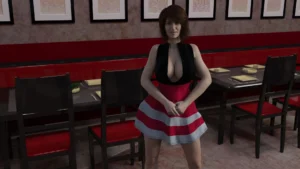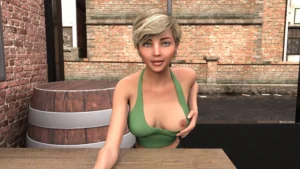
Where the Heart Is
Play Where the Heart Is
Where the Heart Is review
Unraveling the narrative complexity and gameplay mechanics of this choice-driven experience
In the evolving landscape of story-driven adult games, ‘Where the Heart Is’ stands out with its intricate character dynamics and branching narratives. This Ren’Py-powered visual novel challenges players to navigate complex relationships through meaningful choices that shape both immediate outcomes and long-term story arcs. With its HD-rendered visuals and emphasis on emotional consequences, the game offers a unique blend of mature storytelling and strategic decision-making that rewards multiple playthroughs.
Gameplay Mechanics and Narrative Design
Gameplay Mechanics and Narrative Design
Imagine this: you’re staring at your screen, torn between two dialogue options. Do you tell your sarcastic roommate you love their cooking (you don’t), or risk honesty and watch their pixelated face crumple? 😬 Welcome to “Where the Heart Is”—a game where every choice feels like tossing a pebble into a pond, then realizing you’ve accidentally started a tidal wave. 🌊 This isn’t just another visual novel; it’s a masterclass in adult visual novel mechanics that turn casual flirting and heated arguments into high-stakes drama. Let’s break down how it all works—and why you’ll keep hitting “New Game” just to see what happens if you pick that option.
Choice-Driven Relationship Building
Here’s the deal: most games treat relationships like checklists. Bring Character A flowers +10, forget their birthday -20. “Where the Heart Is” laughs in the face of that simplicity. 💐💥 Its relationship consequence system doesn’t just track points—it evolves. Think of it like real life: complimenting someone’s outfit might earn you brownie points today, but if you’ve been ignoring their texts for weeks? That same compliment reeks of desperation.
The game’s conversation system is a spiderweb of branching narrative paths. During one playthrough, I accidentally flirted with two characters at a party. 🕷️🍷 Cue a messy love triangle, a shattered friendship, and a very awkward family dinner. The kicker? These outcomes aren’t just “good” or “bad.” They’re nuanced, messy, and human.
💡 Pro Tip: Save often. The game autosaves, but trust me—you’ll want a “What If?” folder for those spicy alternate timelines.
Key mechanics here include:
– Dynamic Relationship Meters: Hidden values that shift based on combinations of choices, not single actions
– Time-Sensitive Decisions: Miss a call? That opportunity’s gone forever. ⏳
– Contextual Memory: Characters remember how you resolved conflicts, not just that you did
Character Archetypes and Development Paths
Let’s talk about the heartthrobs (and heartbreakers) you’ll meet. 🎭 “Where the Heart Is” serves up familiar tropes—the childhood friend, the brooding artist, the chaotic ex—but twists them into something fresh. Take Emma, the “girl next door.” Sure, she bakes cookies and blushes easily, but push her storyline, and you’ll uncover a secret ambition to quit her corporate job and backpack through Asia. 🎒🌏
What makes these characters sing is their development paths. Each has:
– 3 Core Personality Traits (e.g., “Loyal,” “Ambitious,” “Insecure”)
– 5 Relationship Milestones (from “Strangers” to “Soulmates”)
– 2-4 Possible Endings (including some devastating betrayals)
The game’s Ren’Py game customization shines here. Unlike rigid engines, Ren’Py lets creators layer traits and reactions organically. Ever notice how Emma’s voice gets sharper when you dismiss her dreams? That’s not random—it’s code tracking your respect for her ambitions.
| Character | Trust Threshold | Romance Threshold | Conflict Trigger |
|---|---|---|---|
| Emma | 40% | 75% | Ignoring career talks |
| Marcus | 60% | 65% | Flirting with others |
| Lena | 30% | 80% | Pushing for commitment |
⚠️ Warning: Crossing a “Conflict Trigger” isn’t always bad! Lena’s fear of commitment? Push hard enough, and you might unlock her secret soft side. Or get slapped. 🖐️
Visual Storytelling Techniques
You could mute this game and still feel the tension. Why? HD character renders that make every eyebrow twitch and lip quiver matter. When Marcus narrows his eyes after you cancel plans, you don’t need text to know he’s hurt—it’s written in the way he crosses his arms and looks away. 👀✨
The art team nailed three things:
1. Micro-Expressions: A flicker of jealousy, a suppressed smile—tiny details that sell big emotions
2. Environmental Storytelling: Lena’s apartment changes as she opens up (goodbye takeout boxes, hello framed photos) 🏠
3. Lighting Shifts: Warm golden hues for romantic moments, harsh blues during arguments
But the real star? The branching narrative paths reflected visually. Choose to reconcile with an ex, and later scenes show them lingering in the background at parties. Pick a solo career path, and your apartment gradually fills with awards instead of love letters. 🏆💔
Why This All Matters
“Where the Heart Is” isn’t just a game—it’s a mirror. 🪐 The adult visual novel mechanics force you to confront real-world truths: every choice has weight, people are complicated, and yes, sometimes you can’t fix what you broke. But that’s what makes it brilliant. With its relationship consequence system and HD character renders, it turns pixels into people and clicks into connections. So go ahead—mess up, reload, and fall in love again. After all, isn’t that what hearts (and games) are for? 💖🎮
Through its sophisticated blend of emotional storytelling and player agency, ‘Where the Heart Is’ redefines expectations for narrative depth in adult-oriented games. The title demonstrates how mature themes can be handled with nuance when supported by strong character writing and meaningful choice systems. As the genre continues evolving, this game serves as both a benchmark for quality and an invitation for players to explore complex human relationships through interactive fiction.





























